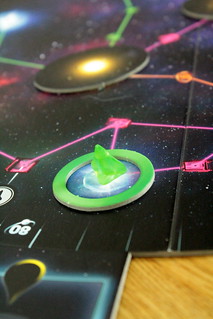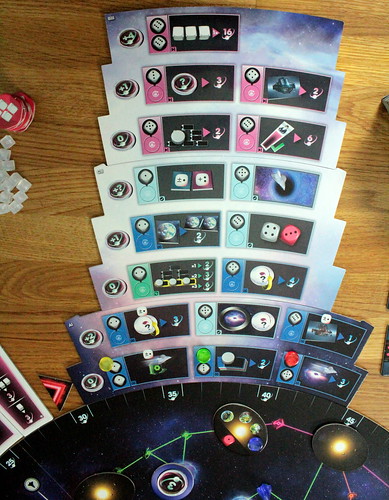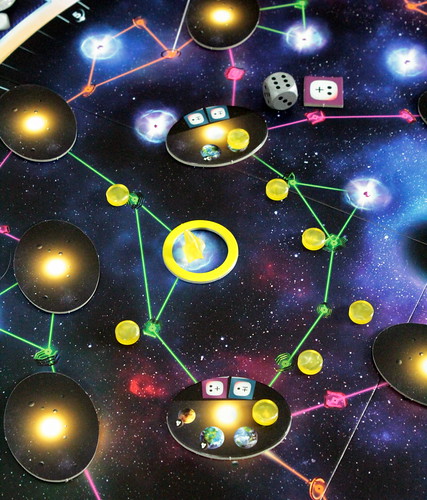| Strategy | Luck |
|---|---|
| Interaction | Components & Design |
| Complexity | Score |
Building pulsar-powered power plants, so called gyrodynes, is your job in Vladimír Suchý’s Pulsar 2849. A gyrodyne is basically a stellar scale dynamo, a ring built around a pulsar that turns with the force of the rotating star and transmits the energy generated elsewhere. But what powers the construction of a structure of that magnitude? Dice!
Forget the laws of physics, all you need are the rules of the game

Broken down to the most basic pieces Pulsar 2849 is a dice drafting and action selection game where players compete for the most victory points. It’s never quite that simple, of course, and while you expect the action selection part to take some strategic finesse you shouldn’t underestimate the dice drafting either.
Each player drafts two dice, the first one clockwise from the first player, the second counter-clockwise from the last player. Which dice you get is not the only thing you decide with your drafts. You also move up or down on the initiative or the engineering track, depending whether you pick a die above or below the median rolled this round. Moving on the initiative track affects player order for the next round. Your position on the engineering determines how many engineering cubes you get. You’d prefer to be first on both tracks, but then you can’t take the more valuable dice. The game just started, and already you have a dilemma.
Things don’t get easier when it gets to using those dice. There are too many things you want to do and too few dice to do them all. The first thing you need to build a gyrodyne is a pulsar, and to claim one of those you fly around in your survey ship.
Flying is the most versatile action in terms of dice. Any dice is good to fly, its face value tells you how many spaces you must move your ship. Most spaces are boring jump gates to move through. Some spaces are valuable pulsars that you may claim for yourself when you end your move on one of them. The third type of space are planetary systems. If you move through one of those you may establish a station on an uninhabitable planet. Ending your move in a system is better, you get to colonize an inhabitable planet and collect the bonus for that system. All planets you claim are valuable because you score points based on the systems you are established in at the end of the game.

But let’s get back to pulsars. After you claim one you want to construct a gyrodyne next. That’s a two-point-five step process. Step one: buy a gyrodyne. You pay a die with value one, two, or four for a small, medium, or large gyrodyne, respectively. Step point five: place the gyrodyne on a pulsar you claimed. It is now under construction. That’s only half a step because you don’t pay a die to do it. Step two: finish construction. That takes a three, five, or six for the different size of gyrodynes. From now one they generate one, two, or three victory points for you per round.
Now that you have that energy it still needs to go somewhere. That’s why you build transmitter arrays. These don’t go on the board, you build them from tiles in your player area. Those tiles come in different configurations of dice you need to build them and rewards they pay out once or every round. There’s no tile real placement aspect in Pulsar 2849, however. Just having the tiles is enough to gain most of their rewards. The only reason you want to link them up is that linking two completed transmitter tiles gives you a red bonus dice you may use for an extra action. That’s 50% more actions this round, so getting bonus dice is a pretty big deal.
That covers your core business, but there are still more things to do with dice. One is to patent technologies from the three technology boards. Technologies come in three flavors. Some give you a one-time bonus in points, engineering cubes or bonus dice. Some give you something extra in every production phase or whenever you take a specific action. The last kind scores bonus points at the end of the game. To get the most out of those you might decide on one at the start of the game and prepare for it. That’s profitable, but dangerous. Each technology can only be patented by two players, so you may not get what you want. For each technology board there are four options. The different combinations of those have a big impact on the game and contribute a lot to its replayability.

The projects on your headquarter board are similar to technologies. The only difference is that they are only available to you. They can give you some of the same things as technologies, plus an additional option. Some projects allow you to do a Gate Run. When you do a Gate Run you try to pass as many jump gates of the right color as you can with one move and score points for each of them.
If all those options still didn’t give you anything useful to do with your dice you can always invest into your future. A one or two buys you a modifier token that you can use to modify a die’s value in the future. It’s a decent last resort to use your dice, but mostly you want to avoid using it. There are better things to do with your dice, and better ways to earn modifier tokens.
All the above you do for only eight rounds before the game ends. That’s sixteen actions without bonus dice. Twenty-four actions at most, if you manage to snatch a bonus die every round. Especially in the first two rounds that’s pretty tough. Expect an average of twenty actions before the game ends. Then you get “some” final victory points. The “some” is in quotes because some strategies score the majority of their points here. That includes the points from end-of-game patents, the bonus points for colonizing many systems, and one more feature we didn’t talk about yet: goal tiles.
There are three goal tiles per game, scoring points for different achievements. A certain number of systems settled, number of patents, number of gyrodynes of the same size, and so on. For each of them, you must complete the basic objective to score. Then you may pay engineering cubes to score even more points. Besides buying bonus dice the goal tiles are the main reason you want those cubes.
Where does all that get us in the end? The Verdict
Pulsar 2849 is a fiendish game. When you first read the rules, you may feel overwhelmed by all the options you have to understand. Then you start playing and you quickly learn how things are connected. You’ll think that picking two dice and taking actions with them is pretty simple. And then you’ll think about all the things you want to do, realize you have twenty-four actions at most, and despair.

And the great thing is, all those things are true. Pulsar 2849 gives you many options. How those options are connected is logical and easy to keep in mind. The learning curve is much less steep than Suchý’s The Prodigals Club, for instance. And you do have a very limited number of moves, so you have to focus your strategy. Where you focus it is completely up to you. No way to score points is better than the others. We’ve had games won simply by the person with the most gyrodynes, just like we had games won by the player that didn’t build any.
The winner is not determined by luck, either. There are dice being rolled in Pulsar 2849, so luck is not completely out of the picture. But its impact on the outcome is insignificant next to how you use the dice you can get. Adapting to the many different combinations of technology boards and goal tiles is key. You don’t want to waste your precious actions on anything that won’t score points.
The dearth of actions is what makes Pulsar 2849 great. Not only does it put a lot of pressure on your decisions what to do, it also works to keep the game short… ish. Pulsar 2849 is one of the few strategy games that fits into the game time given on the package even the first time you play.
Pulsar 2849 is a great strategy game. Deep strategy, many options, straightforward rules, brief turns and only meaningful decisions. Tons of them. The one thing some of you might find lacking is player interaction. Oh, you do interact, in selecting the dice as well as on the various boards. But a lot of the interaction is just coincidental. You will take the dice someone else wanted, but not because someone else wanted it. Your actions are too precious to waste them on messing with the other players. But that, again, is what is awesome about this game. Every action is precious. Pulsar 2849 is as tight as can be, and yet flows without any major delays.















